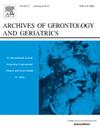Joint association of frailty index and biological aging with all-cause and cause-specific mortality: a population-based longitudinal cohort study
IF 3.5
3区 医学
Q2 GERIATRICS & GERONTOLOGY
引用次数: 0
Abstract
Background
The role of frailty in all-cause, cardiovascular, and cancer mortality is debatable, and the modification effect of biological aging remains unclear. Therefore, we aimed to evaluate the joint association of frailty index and biological aging with all-cause and cause-specific mortality.
Methods
In this population-based cohort study, data were obtained from the National Health and Nutrition Examination Survey (NHANES) and National Death Index (NDI). Demographic variables were extracted, frailty index was constructed, and biological aging was calculated. All-cause deaths, cancer deaths, and cardiovascular disease (CVD) deaths were extracted as outcomes. Cox proportional hazards regression models were used to estimate the correlations, stratified subgroup analyses were used to figure out effect modifiers, and sensitivity analyses were used to confirm the robustness.
Results
A total of 22,729 NHANES participants were included in this study, with 6786 all-cause deaths, 1830 CVD deaths, and 1396 cancer deaths occurred during an average follow-up of 8.5 years over a total of 192,601 person-years. The hazard ratios (HRs) of delayed aging group for all-cause mortality, CVD mortality, and cancer mortality were 0.45 (95 % CI: 0.41–0.49), 0.39 (95 % CI: 0.34–0.45), and 0.54 (95 % CI: 0.46–0.63), respectively, compared to accelerated aging group (P for all comparisons < 0.001). Likewise, the frailty index score was positively associated with all-cause mortality (HR, 1.06 [95 % CI, 1.06–1.06] per 0.01 increase in the frailty index), cardiovascular (CVD) mortality (HR, 1.07 [95 % CI, 1.06–1.07] per 0.01 increase in the frailty index), and cancer mortality (HR, 1.04 [95 % CI, 1.03–1.04] per 0.01 increase in the frailty index). The associations of frailty index with all-cause mortality and CVD mortality were modified by biological aging (P for interaction = 0.044), but cancer mortality was not (P for interaction = 0.482).
Conclusions
Accelerated biological aging is associated with higher frailty index, whereas delayed biological aging is inversely associated with risk of all-cause mortality, CVD mortality, and cancer mortality. Biological aging is effect modification among the associations of frailty index with all-cause mortality and CVD mortality, but not for cancer mortality. These findings suggest that for people with high frailty index and acceleration biological aging, to lower frailty degree and decrease biological aging acceleration by approaches such as lifestyle modifications might be beneficial for individual's longevity and lifespan.
虚弱指数和生物衰老与全因和特定原因死亡率的联合关联:一项基于人群的纵向队列研究
背景:虚弱在全因死亡率、心血管死亡率和癌症死亡率中的作用是有争议的,生物衰老的改变作用仍然不清楚。因此,我们的目的是评估脆弱指数和生物衰老与全因死亡率和病因特异性死亡率的联合关系。方法在这项基于人群的队列研究中,数据来自国家健康与营养检查调查(NHANES)和国家死亡指数(NDI)。提取人口统计学变量,构建脆弱指数,计算生物老化。全因死亡、癌症死亡和心血管疾病(CVD)死亡作为结局。采用Cox比例风险回归模型估计相关性,采用分层亚组分析确定影响因子,采用敏感性分析验证稳健性。结果共有22,729名NHANES参与者被纳入本研究,其中6786名全因死亡,1830名心血管疾病死亡,1396名癌症死亡,平均随访时间为8.5年,共192,601人年。与加速衰老组相比,延迟衰老组全因死亡率、心血管疾病死亡率和癌症死亡率的危险比(hr)分别为0.45 (95% CI: 0.41-0.49)、0.39 (95% CI: 0.34-0.45)和0.54 (95% CI: 0.46-0.63)。0.001)。同样,虚弱指数评分与全因死亡率(HR, 1.06 [95% CI, 1.06 - 1.06] /虚弱指数每增加0.01)、心血管(CVD)死亡率(HR, 1.07 [95% CI, 1.06 - 1.07] /虚弱指数每增加0.01)和癌症死亡率(HR, 1.04 [95% CI, 1.03-1.04] /虚弱指数每增加0.01)呈正相关。虚弱指数与全因死亡率和心血管疾病死亡率的相关性受到生物衰老的影响(交互作用P = 0.044),但癌症死亡率不受影响(交互作用P = 0.482)。结论生物衰老加速与脆性指数增高相关,而生物衰老延迟与全因死亡率、心血管疾病死亡率和癌症死亡率呈负相关。生物老化是虚弱指数与全因死亡率和心血管疾病死亡率关联的效应修正,但与癌症死亡率无关。这些发现提示,对于高脆弱指数和加速生物衰老的人群,通过改变生活方式等方式降低脆弱程度和减缓生物衰老加速可能有利于个体的长寿和寿命。
本文章由计算机程序翻译,如有差异,请以英文原文为准。
求助全文
约1分钟内获得全文
求助全文
来源期刊
CiteScore
7.30
自引率
5.00%
发文量
198
审稿时长
16 days
期刊介绍:
Archives of Gerontology and Geriatrics provides a medium for the publication of papers from the fields of experimental gerontology and clinical and social geriatrics. The principal aim of the journal is to facilitate the exchange of information between specialists in these three fields of gerontological research. Experimental papers dealing with the basic mechanisms of aging at molecular, cellular, tissue or organ levels will be published.
Clinical papers will be accepted if they provide sufficiently new information or are of fundamental importance for the knowledge of human aging. Purely descriptive clinical papers will be accepted only if the results permit further interpretation. Papers dealing with anti-aging pharmacological preparations in humans are welcome. Papers on the social aspects of geriatrics will be accepted if they are of general interest regarding the epidemiology of aging and the efficiency and working methods of the social organizations for the health care of the elderly.

 求助内容:
求助内容: 应助结果提醒方式:
应助结果提醒方式:


